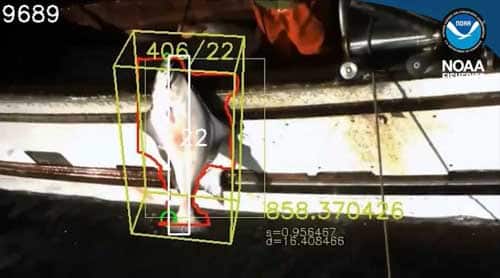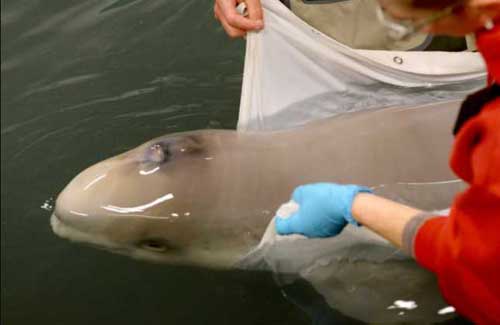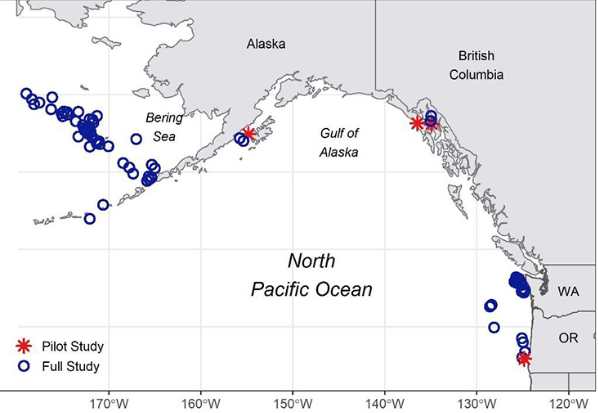
A multiyear electronic monitoring collaboration between the Alaska Fisheries Science Center and the Fisheries Information System Program is improving data collection through the development of innovative electronic monitoring technologies. The goal of the project is to automate video analysis for length measurement and species identification and to integrate electronic monitoring data into overall catch accounting.
Gathering crucial information at sea
The biological and catch composition data gathered by independent observers on fishing vessels through the National Observer Program play a critical role in stock assessments and fisheries management decision-making. However, on some vessels, space for human observers is limited and safety is a concern. To address these issues, the North Pacific Fishery Management Council established an Electronic Monitoring Workgroup, which includes representatives from commercial fishing operations, agencies, and electronic monitoring service providers, that oversaw a program of electronic monitoring cooperative research from 2014 through 2017. The resulting electronic monitoring program represents the first time that data gathered from electronic monitoring collection have been successfully used for catch estimation, marking an important milestone in integrating electronic technologies into the capture, analysis, and integration of fishery-dependent data.

As an important component of electronic monitoring cooperative research, the Alaska Fisheries Science Center Observer Program was tasked with developing new and innovative monitoring technologies to help address the challenges of collecting scientific data while also reducing monitoring costs the North Pacific groundfish and Pacific halibut fisheries on longline vessels. Space or safety constraints on some vessels make made emerging electronic monitoring technologies an attractive alternative, but the potential advantages also have had to be weighed against the often costly and time-consuming process of obtaining and manually reviewing video and still images.
Collaborating through the Fisheries Information System Program
The Science Center worked with NOAA’s Fisheries Information System Program—a state-regional-federal collaboration with the mission of improving access to comprehensive, high-quality, timely fisheries information—to find a solution that would provide effective and cost efficient monitoring.
The first step was to create a camera chute system for measuring halibut bycatch during release from trawler catches. The chutes provide a known orientation of the fish and lighting for the cameras, which are triggered by sensors when each fish passes through. The images are later sorted by an algorithm by class of fish or, in cases of high uncertainty, flagged for manual review. Algorithms make calibrated measurements of each fish, which are compiled to estimate the total number and weight of halibut released.
During pilot testing of the system on a range of vessels, the chute was incrementally improved with such additions as vibration-resistant electronics and hardware built into an increasingly sturdy design. Software improvements allowed even poor-quality images to be processed and results to be provided soon after sorting was completed.
Marking major improvements

When using the chute system, catch estimates can be made quickly and the fish spend less time out of the water, which has the potential to reduce bycatch mortality of high-value, prohibited fish species, such as halibut in the North Pacific.
There are numerous potential side benefits of this work as well. For instance, as speed and accuracy of species identification improves, use of camera chutes can be expanded to more species and sampling situations. After 2 years of data, the fish identification algorithms now reliably identify the most commonly imaged species with about 94 percent accuracy. These same functionalities are also being developed for a stereo camera rail system being tested on longline vessels.
The technologies and lessons learned will be shared via open-source software tools and hardware specifications with the rest of NOAA Fisheries, as well as with the interstate fisheries commissions and regional fishery management councils across the country. In the long term, continued progress may not only lead to improved electronic monitoring and reporting systems for capturing fishery data, but may also support efforts to develop national best practices and policies supporting high-quality, cost-effective, efficient, safe, and productive observer programs.
Source: NOAA Fisheries
[content id=”35021″]








